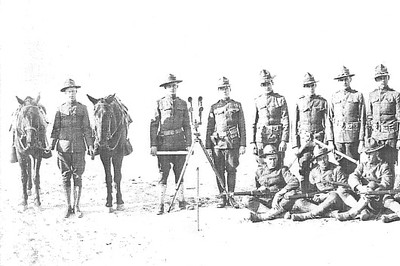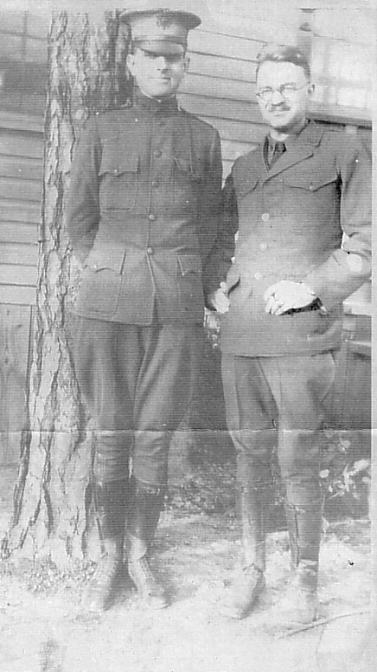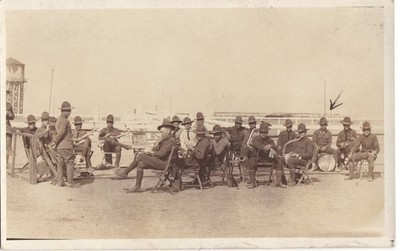WW1
 WW1
WW1
WW1 Insignia in possession of the Regimental museum at Ft. Wood.
 At left is an image of a WW1 uniform enlisted collar
At left is an image of a WW1 uniform enlisted collar
disk from B Company,  48th Infantry Regt.
48th Infantry Regt.
At right is the crossed rifles worn by Lt. George F. Ludington with the Regiment 1917-1918; donated to the Regimental Museum by his son, Nicholas. Lt Ludington is pictured below. The insignia was worn on the high stand-up collar.
 Regimental Headquarters and Headquarters Co. moved by wagon transportation from Camp Hill, to Camp Stuart, VA, 20 Dec 1917, per Special Order 119 Headquarters, Port of Embarkation, Newport News, Va. At left is a picture of the Camp Stuart waterfront at the time.
Regimental Headquarters and Headquarters Co. moved by wagon transportation from Camp Hill, to Camp Stuart, VA, 20 Dec 1917, per Special Order 119 Headquarters, Port of Embarkation, Newport News, Va. At left is a picture of the Camp Stuart waterfront at the time.
Shockingly, by 31 January 1918, seven months after formation, the Regiment had only a fraction of the allowances for clothing and equipment authorized. The following list shows the articles authorized per soldier, and the percent actually on hand in the Regiment. One wonders what in the world they did. It illustrates how ill prepared America was for equipping an expanding army.
(Source: Memo from the C.O. 48th Inf to the Adjutant General of the Army, Subject
“Percentage of equipment and clothing”, dated 31 January 1918 at Camp Stuart,
Newport News, Virginia.)
Coat, Cotton, O.D. 2 – 8.16%
Coat, Wool, O.D. 2 – 35.42%
Breeches, Cotton, O.D. 2 – 23.19%
Breeches, wool, O.D. 2 – 49.69%
Drawers, jean, summer, 3 – 38.40%
Drawers, Winter Wool, 3 – 56.71%
Undershirts, cotton, 3 – 18.27%
Undershirts, Winter Wool, 3 – 55.81%
Stockings, Wool Light, 5 – 122.63%
Shirts, Flannel, O.D. 2 – 36.77%
Shoes, Russet, 1 – 97.84%
Shoes, Field, 1 – 00.02%
Hats, Service, 1 – 41.33%
Leggings, Canvas, 1 – 68.41%
Blankets, 3 – 49.23%
Meat Can, Knife, Fork, Spoon, Cup, Canteen, 1 each – c.54%
For the entire regiment, the number authorized for equipment and the amount
on hand was as follows;
Pistols, Cal. .45 1094 – 0%
Rifle, Cal., .30, Mod. 1903, 0 – 0% (Note the April 30, 1918 report indicates 3201 were
authorized, and 71.63% were on hand)
Automatic Rifles, 192 – 0%
Machine Guns, Marlin Colt 1911, 16, – 37.50%
Tent, Pyramidal, Large, 487 – 74.12%
Tents, Pyramidal, small, 103 – 31.06%
Tents, storage, 2 – 0%
Cots, G.M.3, 763 – 30.53%
Information drawn from the National Archives in Washington, D.C.
From Newport News, the Regiment moved to Camp Sevier as the foundation for forming the 20th Infantry Division. The next page contains photos of the 48th at Camp Sevier donated by a son of the Regiment, Nick Ludington, whose father was with the Regiment at Sevier.
The following pictures have been contributed by Nick Ludington in memory of his father, George F. Ludington who served in the Regiment in WW1. The first 3 are sections of a panoramic photo, center, left and right.





In the picture on the left, Lt Ludington on the left, and on the right on the right. He is joined Ralf Emerson who ran the American Library Association (ALA) building in Camp Sevier.

The Ford truck belonged to the ALA but seems to have been used for a few sightseeing trips.
The next page of WW1 History contains an interview with a WW1 Vet and other information.

Company B, 48th Infantry Regiment, at Camp Sevier, S.C. in 1918.
I apologize for the poor quality and size of the photograph, but it is taken from a microfilm copy of the October 5, 1918, edition of the Camp Sevier
TRENCH AND CAMP newspaper, published by the Army YMCA with the cooperation of The Greenville Daily News under the auspices of the
National War Works Council, YMCA of the United States. Beyond the short caption, there was no article to accompany
the photo. One can just make out the uniforms of campaign hats, leggings, and tents in the background.
Interview with WW1 48th Veteran
In 1983, the Department of the Army sent questionnaires to WWI veterans in a WW1 research
project. The following is one response from Homer Lucas, an 18 year old farmer from Iowa,
enlisted in January 1918 to D Co. 48th Inf.
Why did you enlist? President Wilson's call for volunteers, the German sinking of our ships, and the rumored slaughter of civilians.
Where did you train as a recruit? Camp Hill, Hampton Roads, VA
What were you trained in? Infantry, drilling, guard duty, marksmanship, bayonet, signaling.
At what posts were you stationed during your service? Camp Hill, Newport News, VA;
Camp Sevier, Greenville, S.C., and Camp Jackson, Columbia, S.C.
Did you have any unusual assignments? Truck driving later
What was your opinion of the weapons you saw or used in the service? Used both
Springfield rifle, and later the Enfield. Old timers preferred the Springfield.
What were your opinions of the equipment, clothing and rations you were issued?
O.D. uniforms too hot in the summer. Khaki too cold in the winter. Rations were not too
bad, but we had to drink poor coffee at all meals. Couldn't ask for water.
What did you think of the quality of leadership while you were in the army? Captain
and non-coms O.K. Some lieutenants poor.
Do you recall any instances of particularly good or bad leadership? When captain was
gone a lieutenant was made the company stand at attention on toward an hour when we
didn't hear call for retreat.
What did you think of the discipline at the time? Strict but not harsh
Did you know of any reasons for desertion? Most of us had volunteered for overseas service.
Our outfit kept on drill and guard duty the whole time. One man A.W.O.L. but got across by
boarding ship.
Was there much theft in your unit? Some mostly by New York City recruits.
What form of off-duty recreation were common? Volleyball, track competition.
How did you and your comrades get along with civilians in the U.S.? O.K.
What did you think of the medical and supply services in the service? Not too good. Rough,
stingy Supply Sergeants.
How was the health of your unit? O.K. until flu struck in September. Then quarantine.
What did soldiers use their pay for? Some liberty bonds and some sent home. Otherwise travel on passes and furloughs. Shooting dice and card games.
Was drinking a problem? with many. If so, how was liquor obtained? Uptown on week-end passes
Was there much gambling? Yes If so, what types? Shooting craps and poker
Do you recall any songs that were popular during your military service? "Over There",
"There's a long long trail", "Good morning Mr. Zip"
Do you recall any military slag words or phases peculiar to those time? "C.S. Corporal",
"Altogether Boys, some –", Canned beef was "Canned Willie", Coffee was "Java"
Beef and vegetable stew was "Humgullion Stew"
Other bits of information from the TRENCH AND CAMP:
48th Headquarters Company had a Bombers and Snipers Platoon. An October 19, 1918
article indicates it was equipped with 1 pound trench mortars, and had a sapper's section (Engineers)
in addition to snipers.
The 48th Regiment had a band which in addition to its normal post duties, gave concerts in
Greenville, S.C. The band leader was named Mertent. (16 Nov 1918 edition).
 A postcard made of the band's photo is below. The back of the postcard simply noted that it was the
A postcard made of the band's photo is below. The back of the postcard simply noted that it was the
48th Inf band, and does not indicate to whom the arrow was pointing.
The Daily Drill Schedule for Rifle Companies of the 48th at Camp Sevier for the period October 28 to November 2, 1918 was as follows:
7:00 to 7:30 AM Company police
7:30 to 7:50 AM Setting-up Exercises – no rests
7:50 to 8:20 AM School of the Soldier and Squad
8:20 to 8:30 AM Rest – prepare strength report
8:30 to 9:30 AM School of the platoon
9:30 to 9:40 AM Rest
9:40 to 10:20 AM Bayonet and Grenade Instructions
10:20 to 10:30 AM Rest
10:30 to 11:30 AM Company or Battalion close order drill with the band
1:00 to 2:30 PM Musketry
2:30 to 2:40 PM Rest
2:40 to 3:25 PM Quickening exercises
3:25 to 3:40 PM Rest
3:40 to 4:00PM Company close order and Manual of Arms.
Battalion parades daily at 4:50 PM, Monday & Thursday 3rd Bn, Tuesday and Friday 2nd Bn, Wednesday 1st Bn.
Retreat at 5:00 PM daily
Formal Guard Mount daily except Saturday or Sunday immediately after parade.
